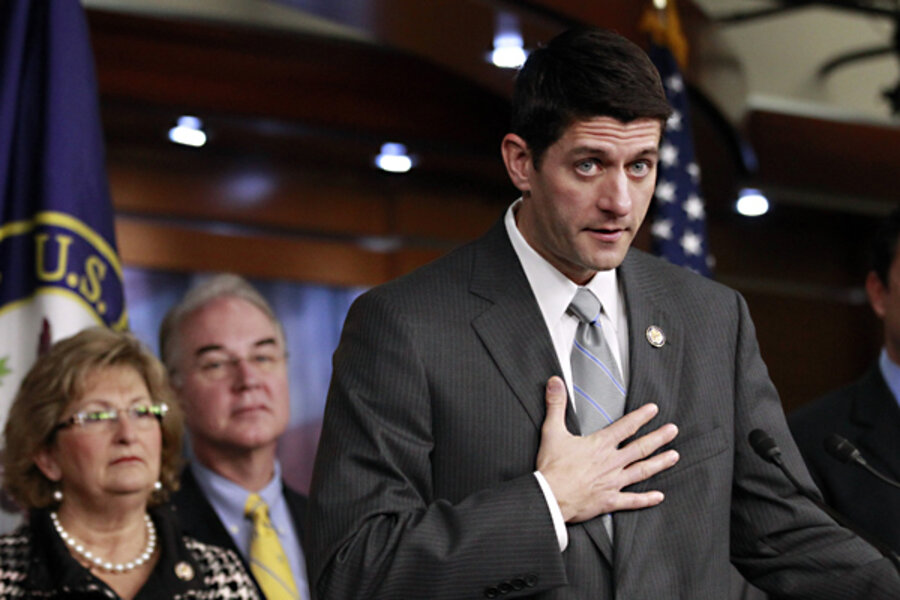Two options for fixing the nation's budget mess
Loading...
With congressional deficit reduction efforts largely collapsed, the question remains: What are we going to do about the nation’s long-term budget mess? Since any realistic deficit reduction plan will require significant new revenues, is a Value-Added Tax a sensible way for government to raise those extra dollars?
In an effort to find out, the Pew Charitable Trusts asked my Tax Policy Center colleagues Eric Toder, Jim Nunns, and Joe Rosenberg to set up something of a cage match: In the blue trunks, a broad-based VAT (think 9-9-9 only much less complicated). In the white trunks, the income tax. And they asked a basic question: What are the pros and cons of using a VAT to cut the deficit compared to an across-the-board hike in income tax rates.
Of course, real deficit reduction would surely involve substantial spending reductions and, in the real world, Congress might raise some new revenues by cutting tax subsidies not just raising rates. But to keep things relatively simple, Eric, Jim, and Joe looked at just two options: raising rates in the existing income tax system or adding a prototype VAT to what we’ve got.
They found that, even with one form of rebate, this version of a VAT would impose a larger tax burden on low- and moderate-income households than an across-the-board income tax rate increase. And it would significantly increase compliance and administrative costs, especially at the beginning.
However, a VAT would result in a smaller increase in marginal tax rates on labor than an income tax rate hike. And it would intrude on fewer economic decisions, especially related to savings and investment.
The goal of the exercise was to reduce the ratio of debt to Gross Domestic Product (a standard way of measuring red ink) to 60 percent. They looked at doing this by 2020, 2025, and 2035. The debt/GDP ratio is about 69 percent today and the Congressional Budget Office predicts it will rise to 187 percent by 2035 if the government keeps doing what it has been doing (maintaining the 2001/2003/2010 tax rates, continuing to protect middle-income families from the Alternative Minimum Tax, etc.).
To hit the 60 percent target by 2020, average after-tax incomes would have to be cut by 8.7 percent under the VAT or 9.3 percent with tax rate hikes, relative to incomes under today’s tax rules. Income for the lowest-earning 20 percent of households would be cut by 1.8 percent under the VAT but only 0.5 percent if Congress raised income tax rates. Middle-income households would see their after-tax income fall by 7.9 percent under the VAT but just 5.5 percent from higher rates. By contrast, the rich would be better off with the VAT. After-tax incomes of the top 1 percent would shrink by 9.6 percent compared to 17.2 percent with a rate hike.
Regular people can probably stop here, but if you are a serious tax wonk, here are some details on this prototype VAT and the income tax alternative:
This VAT has a very broad base (no exemptions for food and clothing, for example). However, it does not tax Medicare and Medicaid payments, spending by non-profits, or state and local sales taxes (yes, Virginia, some VATs do) . Combined, it would tax about 60 percent of all consumption and about 40 percent of GDP.
The VAT would partially protect low-income households with two rebates—one for workers and a second for Social Security recipients and others who get government cash transfers. Assuming current tax policy does not change, they estimate it would take a VAT rate of 22.9 percent in 2015 to meet the debt target in 2020. Because the glide path would be longer, the 2015 rate would only have to be 16.7 percent if the goal is to hit 60 percent by 2035.
To hit the 2020 target though an across-the-board income tax rate increase, rates in 2015 would rise from today’s 10-15-25-28-33-35 to 17.1-25.6-42.6-47.7-56.3-59.7 (yup, that’s a top income tax rate of almost 60 percent). As with the VAT, income tax rates would also be lower if the aim was to reach the 60 percent goal in 2025 or 2035. Rates on capital gains and dividends would also have to rise—to a top rate of 29.4 percent in 2015 if Congress wanted to meet its deficit target by 2020.
Not surprisingly, Eric, Jim, and Joe found flaws in both options. Without entitlement cuts hitting this ambitious debt target forces painful tax hikes either way. And, of course, a differently designed VAT would have yielded a different outcome. But in its cage match with a big income tax rate increase, the VAT at least gets a draw.





